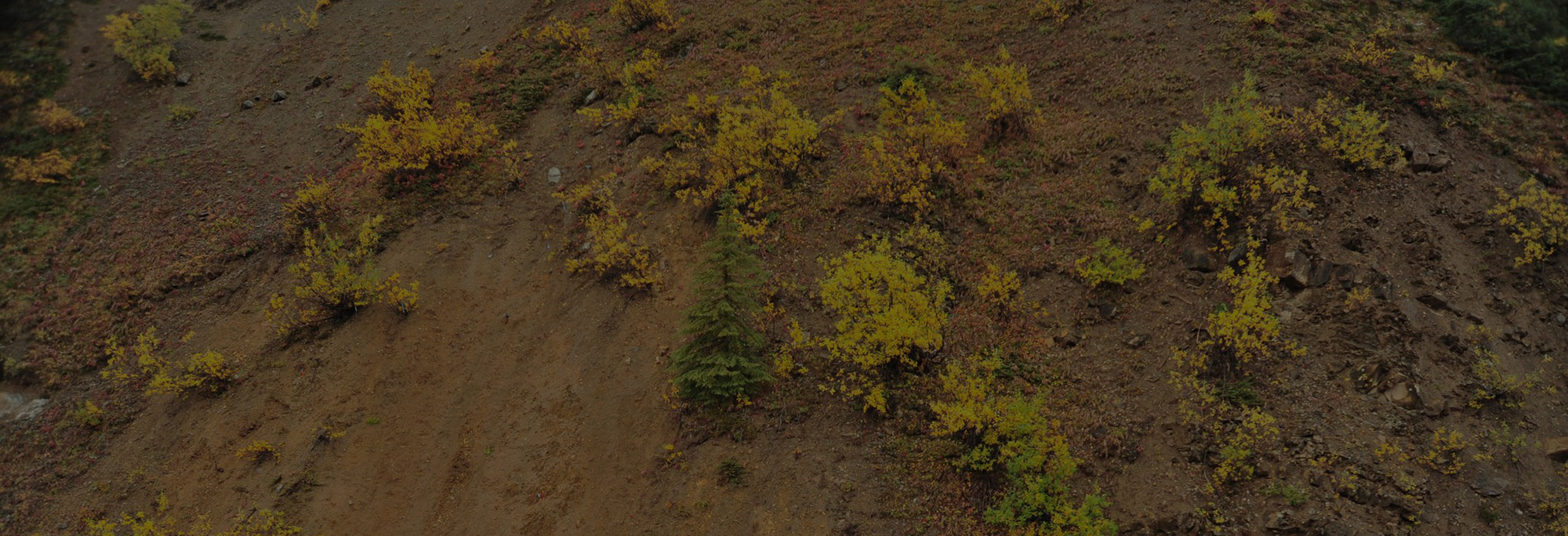- Hole V-21-003 returned 1.56 g/t Au over 125.0 m from surface, within a broader mineralized zone averaging 1.25 g/t Au over 168.7 m
- Hole V-21-004 returned 0.90 g/t Au over 69.5 m from 65 m depth, within a broader mineralized zone averaging 0.77 g/t Au over 93.8 m
- Length, width and depth of the discovery remain open, with drill on site to commence drilling Spring 2022.
Vancouver, B.C., February 10, 2022: SNOWLINE GOLD CORP. (CSE: SGD) (US OTC: SNWGF) (the “Company” or “Snowline”) is pleased to provide additional Phase I drill and exploration results from the Valley zone on its Rogue gold project in the Yukon Territory, Canada. As with the first two holes (released previously), holes V-21-003 and V-21-004 each intersected broad zones of high gold values associated with visible gold in sheeted vein arrays. V-21-003 averaged 1.56 g/t Au over 125.0 m from surface, within a broader sheeted vein array zone 1.25 g/t Au over 168.7 m, also from surface. Hole V-21-004, collared farther from the intrusion, also encountered strong gold grades in sheeted veins, running 0.90 g/t Au over 69.5 m from 65.0 m depth.
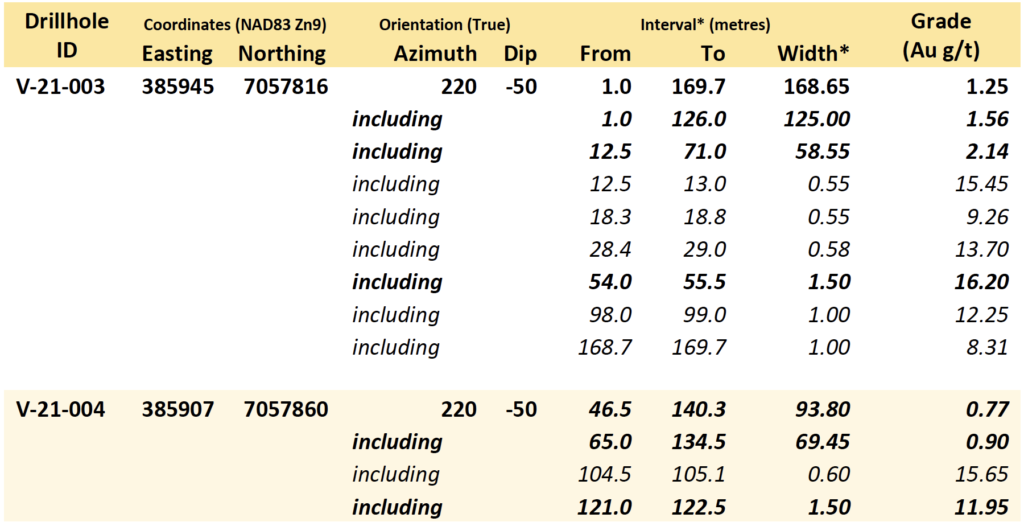
“These results build on what was already a remarkably successful first season for Snowline,” said Scott Berdahl, CEO and director of Snowline Gold Corp. “V-21-003 and V-21-004 were drilled specifically to crosscut and better test the width of the sheeted vein arrays at Valley. Hole V-21-003 began in a mineralized interval, so that width remains open. That it intersected a higher total gold content than any other hole drilled by Snowline in 2021 is a promising sign both for the Valley target and the broader Rogue project. Hole V-21-004 also hit strong grades, demonstrating that the system is open along its length, which continues beyond the margins of the intrusion. We are eager to follow up on these results with a significant drill program at Valley in 2022.”
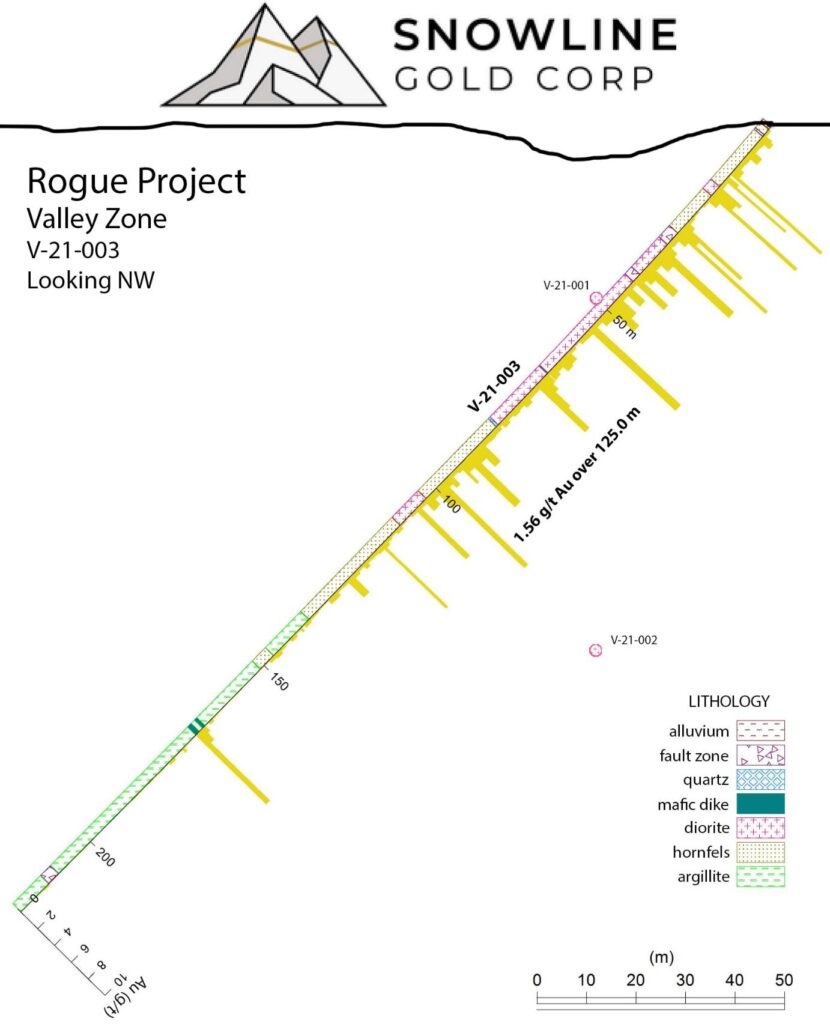

Based on the geological setting, the style of mineralization and the geochemical and mineral associations observed in drill core, Valley is interpreted to be a reduced intrusion-related gold system (RIRGS). Elsewhere, RIRGS gold deposits are known to form important commercial gold resources, including Victoria Gold Corp.’s Eagle Mine in the Yukon and Kinross Gold Corporation’s Fort Knox Mine in Alaska. Both deposits are hosted in intrusive rocks analogous to those at Valley.
Valley is currently a discovery-stage bulk-tonnage prospect with no estimated resources nor reserves. At this early stage it is not possible to determine the size of the mineralized system nor whether it will prove to be economically viable.
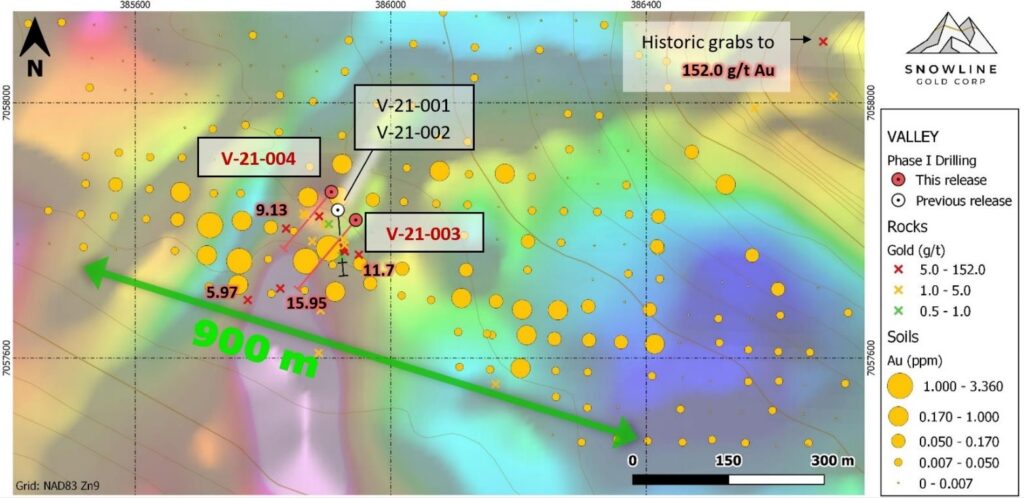
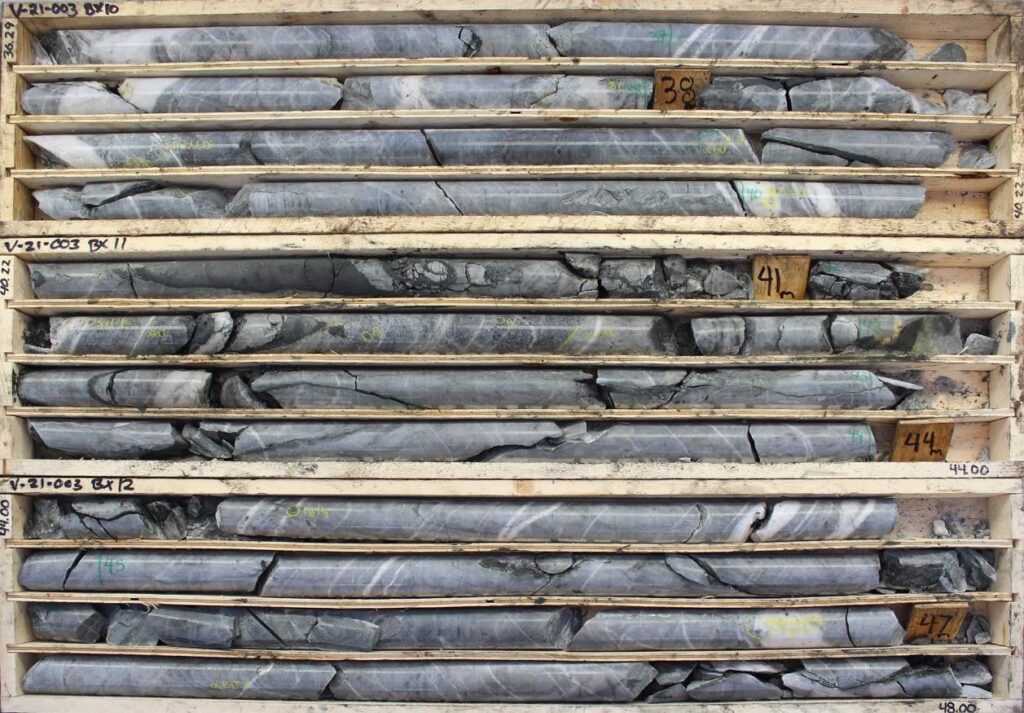
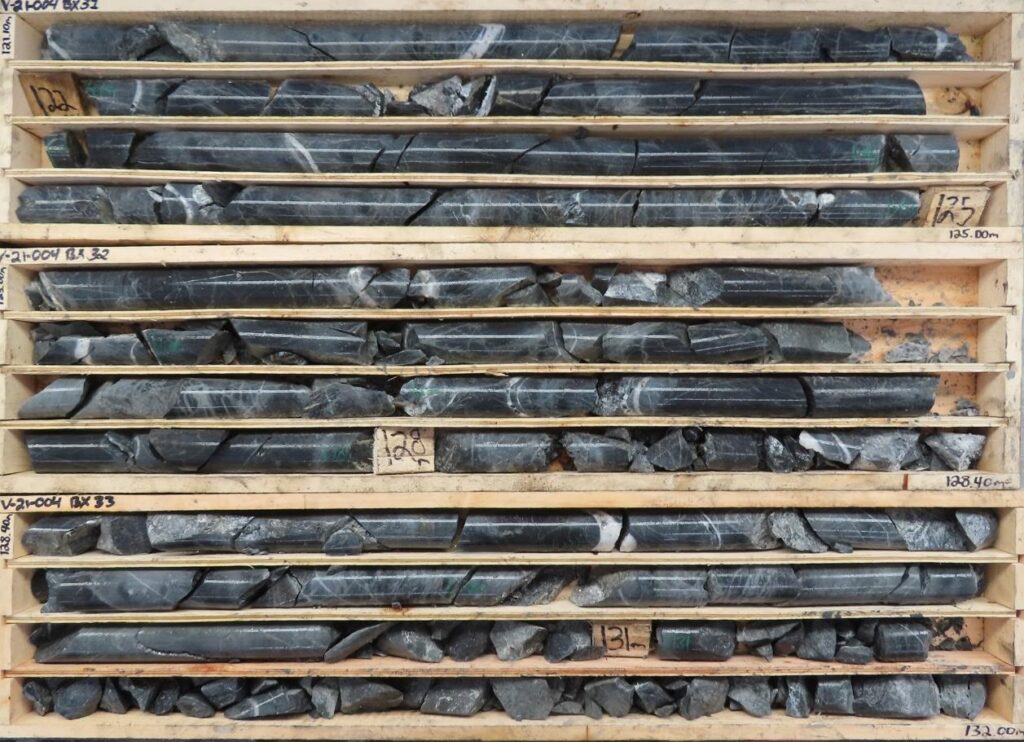
UPCOMING EXPLORATION
With over $8.5M CAD in the treasury, Snowline is actively preparing for a busy 2022 exploration season. The upcoming program will see at least two drills turning on an 8,000+ m program focused on the Company’s Jupiter and Valley discoveries along with nearby targets. This work continues to build toward establishing North America’s newest gold district in the Yukon’s Selwyn Basin.
The Company currently has a diamond drill under contract and on site at Valley, overwintering for a quick and cost-effective resumption of drilling in Spring 2022. Given the scale of the associated geochemical anomaly, the extent of sheeted veins observed on surface and the potential for higher vein densities within the intrusion, a 3000+ m drill program is planned at Valley to better understand the scale and continuity of the mineralized zone.
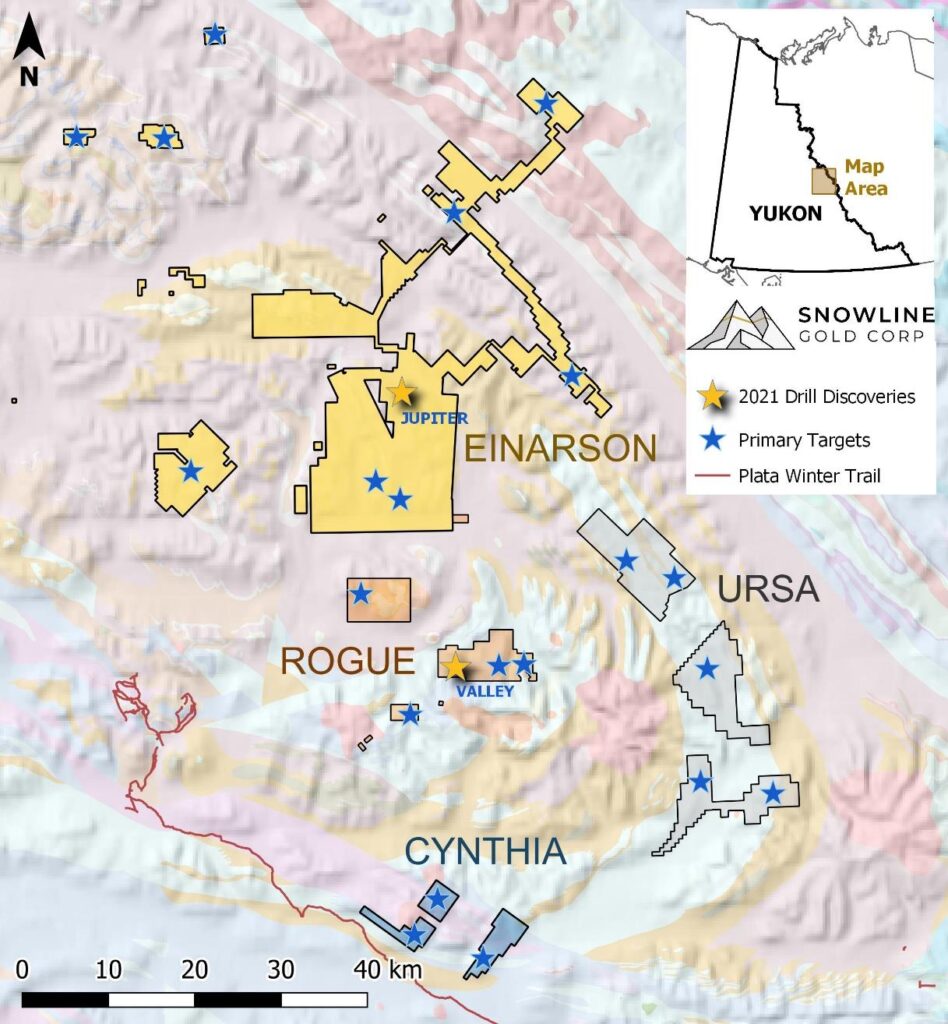
QA/QC AND QUALIFIED PERSON
On receipt from the drill site, Valley’s NQ-sized drill core was systematically logged for geological attributes, photographed and sampled at Snowline’s 2021 field camp. Smaller sample lengths were used to isolate zones of interest, otherwise a default 1.5 m downhole sample length was used. Core was cut in half lengthwise, with one half collected for analysis and one half stored as a record. Standard reference materials, blanks and duplicate samples were inserted by Snowline personnel at regular intervals into the sample stream. Bagged samples were sealed with security tags to ensure integrity during transport. They were delivered by expeditor and by Snowline personnel to ALS Laboratories’ preparatory facility in Whitehorse, Yukon, with analysis completed in Vancouver.
ALS is accredited to ISO 17025:2005 UKAS ref 4028 for its laboratory analysis. Samples were crushed by ALS to >70% passing below 2 mm and split using a riffle splitter. 250 g splits were pulverized to >85% passing below 75 microns. An aqua regia digest with an inductively coupled plasma mass spectroscopy (ICP-MS) finish was used for 51-element analysis on 50 g samples (ALS code: Au-ME-TL44). For V-21-003, as with previous Valley zone holes V-21-001 and 002, all samples were re-analysed for gold content by fire assay with an inductively coupled plasma atomic emission spectroscopy (ICP-AES) finish on 30 g samples (ALS code: Au-ICP21). For V-21-004, as a cost saving measure, any sample retuning less than 50 parts per billion gold was not reanalyzed by fire assay. At the time of writing, all such samples from V-21-004 have been resubmitted for fire assay to provide consistency in the dataset and because aqua regia appears to under-report gold concentrations by an average of 12% in holes V-21-001, 002 and 003 compared to the more rigorous fire assay analysis technique. Any sample returning >10 g/t Au was reanalysed by fire assay with a gravimetric finish on a 50 g sample (ALS code: Au-GRA22).
Samples with visible gold and other samples returning >5 g/t Au will undergo further processing, analysing the screen rejects to determine whether the screening process could introduce a sampling bias in current results by excluding coarse gold from analysis, resulting in an under-reporting of true grades.
Information in this release has been prepared and approved by Scott Berdahl, P. Geo., Chief Executive Officer of Snowline and a Qualified Person for the purposes of National Instrument 43-101.
ABOUT SNOWLINE GOLD CORP.
Snowline Gold Corp. is a Yukon Territory focused gold exploration company with a seven-project portfolio covering >100,000 ha. The Company is exploring its flagship 72,000 ha Einarson and Rogue gold projects in the highly prospective yet underexplored Selwyn Basin. Snowline’s project portfolio sits within the prolific Tintina Gold Province, host to multiple million-ounce-plus gold mines and deposits including Kinross’ Fort Knox mine, Newmont’s Coffee deposit, and Victoria Gold’s Eagle Mine. Snowline’s first-mover land position provides a unique opportunity for investors to be part of multiple discoveries and the creation of a new gold district.
ON BEHALF OF THE BOARD
Scott Berdahl, MSc, MBA, PGeo
CEO & Director
For further information, please contact:
Snowline Gold Corp.
+1 778 650 5485
info@snowlinegold.com
CAUTIONARY NOTE REGARDING FORWARD-LOOKING STATEMENTS
This news release contains certain forward-looking statements, including statements about the Company reviewing its newly acquired project portfolio to maximize value, reviewing options for its non-core assets, including targeted exploration and joint venture arrangements, conducting follow-up prospecting and mapping this summer and plans for exploring and expanding a new greenfield, district-scale gold system. Wherever possible, words such as “may”, “will”, “should”, “could”, “expect”, “plan”, “intend”, “anticipate”, “believe”, “estimate”, “predict” or “potential” or the negative or other variations of these words, or similar words or phrases, have been used to identify these forward-looking statements. These statements reflect management’s current beliefs and are based on information currently available to management as at the date hereof.
Forward-looking statements involve significant risk, uncertainties and assumptions. Many factors could cause actual results, performance or achievements to differ materially from the results discussed or implied in the forward-looking statements. Such factors include, among other things: risks related to uncertainties inherent in drill results and the estimation of mineral resources; and risks associated with executing the Company’s plans and intentions. These factors should be considered carefully, and readers should not place undue reliance on the forward-looking statements. Although the forward-looking statements contained in this news release are based upon what management believes to be reasonable assumptions, the Company cannot assure readers that actual results will be consistent with these forward-looking statements. These forward-looking statements are made as of the date of this news release, and the Company assumes no obligation to update or revise them to reflect new events or circumstances, except as required by law.
